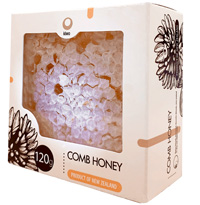Honeycomb 120g 4.2oz

Honeycomb, filled with Clover Honey is a definite favourite on toast at breakfast time.
Clover is a New Zealand classic honey. The honey is made by bees from the flower of the clover plant. This is a common plant seen on New Zealand pastoral grasslands.
Colour varies White to Red depending on where in NZ the honey is harvested. Red Clover is often harvested in the North Island, and White Clover is more often South Island produce.
Honey comb is harvested straight from the hive without any extraction. The ‘Frame’ which holds the honey comb is sectioned by cutting through the comb using simple, square comb cutting tools.
Clover or trefoil are common names for plants of the genus Trifolium (Latin, tres “three” + folium “leaf”), consisting of about 300 species of plants in the leguminous pea family Fabaceae.
Biology. A group of clovers is called a cluff. The highest diversity of types of clovers is found in the temperate Northern Hemisphere, but many species also occur in South America and Africa, including at high altitudes on mountains in the tropics.